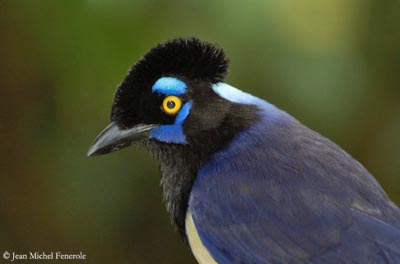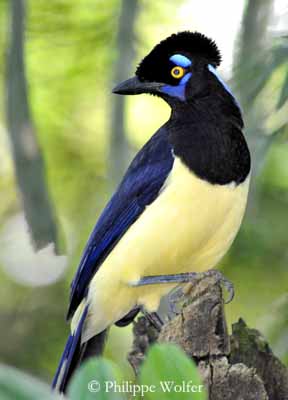
Fr: Geai acahé
All : Kappenblaurabe
Esp: Chara Moñuda
Esp: Argentine: Urraca común
Esp: Bolivia: Urraca común
Esp: Paraguay: Urraca
Esp: Uruguay: Urraca Común
Ital: Ghiandaia occhidorati
Sd: Plyschtofsskrika
Port : Gralha-picaça
Photographers:
Marc Chrétien
MURINUS
Jean Michel Fenerole
Photos d’Oiseaux
Philippe et Aline Wolfer
OISEAUX D’ARGENTINE
Text by Nicole Bouglouan
Sources:
HANDBOOK OF THE BIRDS OF THE WORLD Vol 14 by Josep del Hoyo-Andrew Elliot-David Christie - Lynx Edicions –
ISBN: 9788496553507
BirdLife International (BirdLife International)
XENO-CANTO – Sharing Birds sounds from around the world
Plushed-crested Jay
Cyanocorax chrysops
Passeriforme Order – Corvidae family
BIOMETRICS:
Length: 32-35 cm
Weight: 127-170 g
DESCRIPTION:
The Plushed-crested Jay is a South American species which performs co-operative breeding. Two or three helpers take part in nesting duties and defence against predators.
Adult has bright indigo-blue upperparts. The upperwing shows brownish inner-edges of primary flight feathers. The graduated tail is tipped pale yellowish or white.
On the underparts, chin, throat, neck sides and breast are black. The rest of the underparts varies from creamy-white to pale yellowish. The undertail is graduated with creamy to pale yellowish rectrices and dark bases. The underwing is brownish.

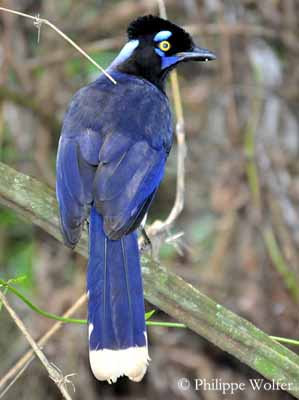
On the head, the black forehead shows stiffened feathers becoming softer on the crown, and forming a velvety crest. The result is a peculiar plush-like head, giving the bird its English name.
Forehead, crown and head sides are black. We can see an ultramarine elongated crescent above the eye. This patch is washed white at top. Another ultramarine-blue spot is below the rear-eye and joins the large cyan-blue malar stripe, forming a V below the eye.
The nape is white washed ultramarine, and the hind neck is pure ultramarine.
The bill is black. Eyes are yellow. Legs and feet are blackish.
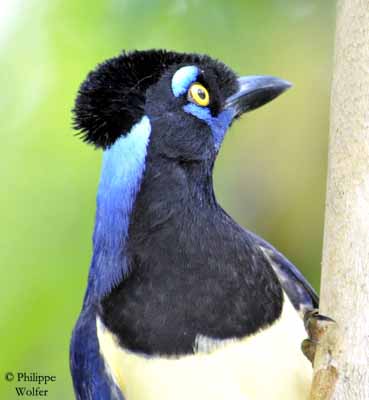
Both sexes are similar.
The juvenile has duller nape, and the facial pattern appears after the first month. The eyes are browner and become yellow at three months.
We can find four subspecies:
C.c. diesingii has more dome-shaped crown, smaller ultramarine eye-patches and malar stripe, paler nape and hind neck, and narrower whitish tail tip.
C.c. insperatus is similar to diesingii with pure white underparts and tail tip.
C.c. tucumanus is similar to nominate race but larger (here displayed).
C.c. chrysops is described here.
VOICE: SOUNDS BY XENO-CANTO
The Plushed-crested Jay has a large repertoire of more than 20 different sounds.
In territorial defence, it gives loud, far-carrying calls. When the birds gather in flocks or move, they give social calls, a single, metallic, low melodious sound.
There are two alarm calls: a single note when the predator is still far off and a phrase of 3-6 shorter notes when it approaches.
The contact calls heard among foraging birds are sequences of 2-3 “chyup-chyup”.
This jay can also mimicry other birds’ calls.
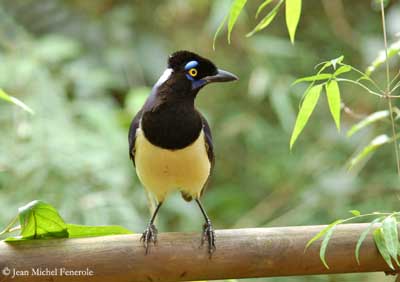
HABITAT:
The Plushed-crested Jay frequents forest and wooded areas, from typical lowland evergreen forest and tropical deciduous forest to temperate rainforest. It is usually seen up to 1500 metres of elevation, but it may occur at 2800 metres in Bolivia.
All kinds of forests and wooded areas are suitable for this species, and especially with maize plantations in the surroundings. It also frequents Eucalyptus plantations and forest edges, and can be seen in suburban areas.
RANGE:
The Plushed-crested Jay occurs in several parts of South America, from N Argentina, to Paraguay and Uruguay, N and E Bolivia. This species is also found in Brazil, south of the Amazon River.
BEHAVIOUR:
The Plushed-crested Jay feeds primarily on small invertebrates, mainly insects, and fruits from several plant species. It can sometimes take nestlings and eggs of other bird species, and frogs. It regularly feeds on maize when available and other seeds during the winter.
The Plushed-crested Jay does not eat the animal items when captured, but it brings them to another place. It holds the food with the feet and pecks with the bill. It removes the wings of the large insects.
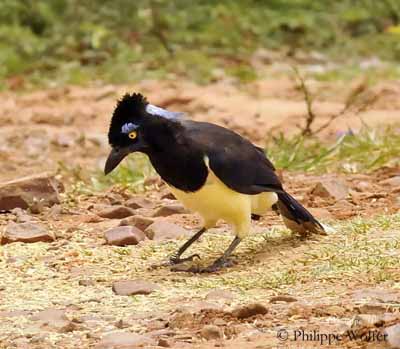
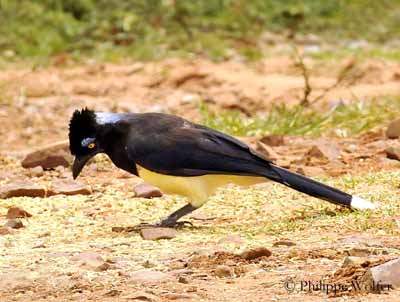
It forages by hopping on the ground, but also among the foliage and on the branches. When the resources are abundant, it often stores the food on the ground covered with leaves, or in trees between the branches. They often forage in flocks of 3-10 birds at all levels.
Each bird moves singly across the forest clearing and edges. They also fly for short distances over more open areas. On the ground, it turns over the dead leaves by sweeping bill sideways.
The Plushed-crested Jay is a communal breeder, and commonly 2-3 helpers take part in nesting duties and defence. But if the co-operative breeding seems to be frequent, this species also breeds in pairs and the young remain within the family group for several months.
Mate selection occurs at noisy, communal roosts. The male performs courtship feeding to the female, and she responds by jiggling wings and tail. They are monogamous but the pair-bonds are not for the life.
They roost communally with some birds as sentinels.
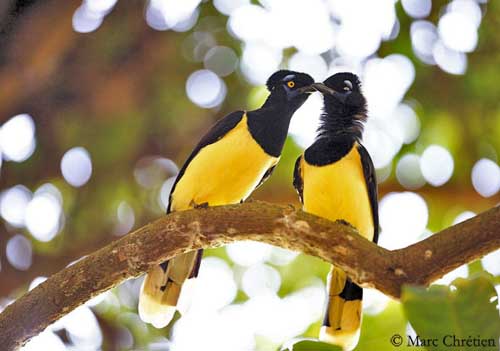
The Plushed-crested Jay is sedentary in its range.
FLIGHT:
The Plushed-crested Jay performs short flights over open areas when foraging. The short, rounded wings allow the bird to fly easily from branch to branch among the trees in forested areas. Its flight is undulating, with flapping interspersed with gliding.
REPRODUCTION:
The breeding season occurs between October and December in Paraguay and S Brazil.
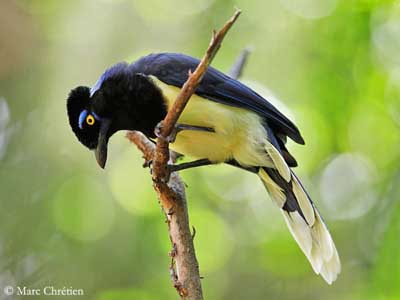
The Plushed-crested Jay is sometimes co-operative breeder, with two or three young of the previous year as helpers, taking part in nesting duties and defence against predators by mobbing and chasing them away from the territory.
The nest is cup-shaped and often placed between 4 and 7 metres in the thick foliage of a tree. The nest is made with twigs, and the interior is lined with finer twigs and plant fibres, layers of bark and roots. Other soft materials can be added such as feathers, grass and leaves.
The female lays 2-4 speckled eggs and she incubates during 18-20 days. The male feeds her during this period. The chicks fledge 22-24 days after hatching, but they are fed by adults for three months more after leaving the nest.
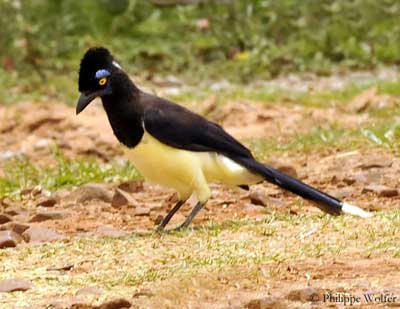
DIET:
The Plushed-crested Jay feeds mainly on small invertebrates, and mostly insects. It also takes fruits from several plant species such as Ficus and Phylodendrum, Casearia and Syagros, and also Psidium and Rapanea.
Nestlings and eggs of other bird species, frogs, seeds and maize are also taken, according to the food availability.
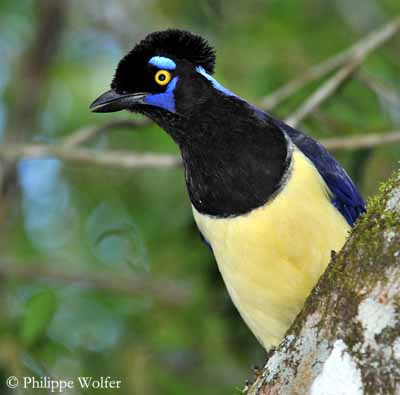
PROTECTION / THREATS / STATUS:
The Plushed-crested Jay is threatened by the deforestation, but fortunately, this species is able to live in isolated forest patches of 10-20 ha, if larger forests are not too far.
Illegal pet trade is also an important threat.
This jay frequents the urban areas in Brazil, and can be common to abundant in its range.
Currently, the populations of the Plushed-crested Jay are not threatened.
